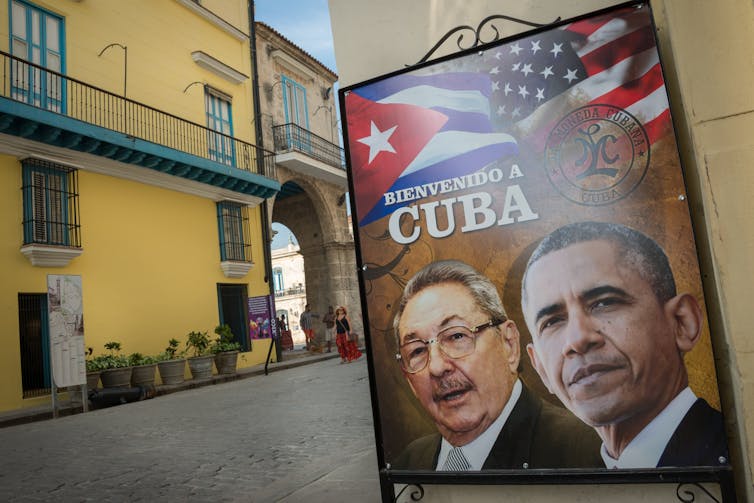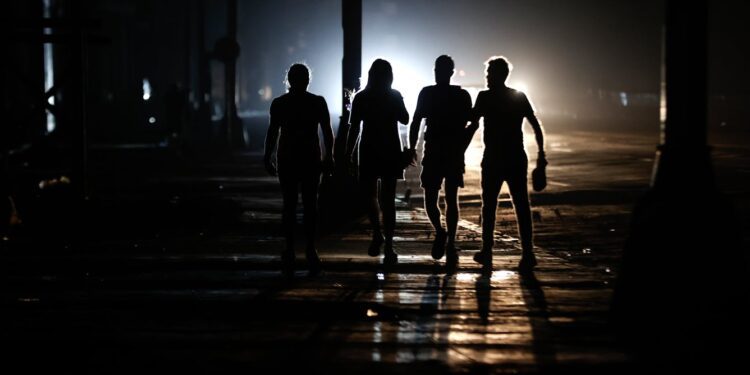Cuba’s national grid collapsed four times in as many days last week, after the island’s largest power plant, Antonio Guiteras, failed. Millions of Cubans are still without power, with food rotting in powerless fridges and many lacking access to clean water.
The Communist government closed schools on October 18 and ordered non-essential public sector activities to stop as work began on restoring the grid. But this was hindered by the arrival of Hurricane Oscar on Sunday night, which unleashed heavy rain and strong winds across eastern Cuba.
Antonio Guiteras is now back online, and Cuban energy officials say electricity has been restored in most of the capital city, Havana, and some outlying areas. But they have warned against too much optimism.
Cuba’s five thermoelectric power plants are obsolete and crumbling. And with oil products accounting for over 80% of power generation, the island depends on Venezuela for fuel shipments. But shipments have been cut in half this year as Venezuela struggles to ensure its own supply, forcing the Cuban government to seek far more expensive fuel on the spot market.
The problem is that the Cuban government is running out of money as it grapples with the island’s worst economic crisis in 30 years, so power cuts of up to 20 hours a day are now common. Indeed, Lazaro Guerra, Cuba’s top electricity official, has said that Cubans “should not expect that when the system comes back online the blackouts will end”.
Cubans line up to buy food at a store in the town of Bejucal as the authorities worked to get the energy system back online.
Yander Zamora / EPA
How did Cuba get here?
The roots of this crisis can be traced back to the cold war when Fidel Castro overthrew the US-backed government of Fulgencio Batista in January 1959. Convinced that the Cuban revolution was the most advanced among all far-left movements in Latin America, the former Soviet Union sided with the island and provided it with industrial goods and technical assistance.
Cuba’s relations with the US worsened dramatically, and by July 1960 it had announced the expropriation of US industrial, banking and commercial operations on the island. Within a few months, the Cuban state had taken over all sugar mills, most industry and trade, half of the land, and every bank and communication network in the country.
Retaliation swiftly followed. The US introduced its first embargo on all exports to Cuba in 1960, with exceptions for food and medicine. And this was followed in 1962 by a ban on all trade and financial transactions with the island. In 1964, the then US president, Lyndon B. Johnson, ordered a multilateral policy of “economic denial”, severely inhibited Cuba’s efforts to foster economic relations with other countries.
The island would receive considerable amounts of aid from the Soviet bloc over the next 30 years. But this only deepened Havana’s dependence on a single export product: sugar, which was purchased at an inflated price as part of the aid programme. In return, Cuba purchased the crude oil it needed to operate its electricity plants.
But, by the time the Soviet Union disintegrated in 1991, Cuba had failed to diversify its industrial structure and move away from its low productivity, monocultural economy. The country enjoyed limited self-sufficiency even in the production of food, with all means of production in the state’s hands.
With the disappearance of its main oil supplier, Cuba was also forced to increase its domestic oil production and turn to Venezuela to meet its energy needs. The US embargo, which has been in place for 62 years, has cost Cuba an estimated US$130 billion (£100 billion), and has limited its access to basic goods and services.
During Barack Obama’s second term as US president, there was a step change in relations between the two countries. Diplomatic relations resumed from 2014 and the embargo was eased, including restrictions on the ability of Cuban-Americans to travel back to the island and send remittances.

In March 2016, Barack Obama became the first US president to visit Cuba since Calvin Coolidge in 1928.
Kimberly Shavender / Shutterstock
This kicked off a boom in private sector activities in Cuba and prompted reforms by the Cuban government aimed at restructuring the economy. However, the government was unwilling to reduce its grip on the centrally planned economy, and the reforms moved too slowly to produce any meaningful improvement.
Then, in his final week in office in 2021, Donald Trump reimposed trade restrictions targeting tourism, remittances, and energy supplies, as well as adding Cuba to the list of “state sponsors of terrorism”. The move led to severe shortages and inflation, both of which were worsened by the pandemic.
Logistical bottlenecks disrupted supplies and inflated shipping costs further. Heavily dependent on tourism, Cuba suffered a severe depletion of its foreign currency reserves.
Patience is running out
The economic situation has continued to decline. Export earnings in 2023 were still US$3 billion short of their pre-pandemic level, and Cuba’s economic output is not expected to return to its level before the pandemic until after 2025.
Half a million people – most of whom were young – left the country for the US between 2021 and 2022. And thousands more have made their way to Brazil, Russia, Uruguay and elsewhere in an exodus that is unprecedented in the history of the island.
The future outlook looks bleak, yet the government is keen to quash dissent. Speaking during the latest blackouts, Cuba’s current president, Miguel Díaz-Canel, said: “We will not accept or allow anyone to act by provoking acts of vandalism, and much less disturbing the civil tranquillity of our people … And that is a principle of our revolution.”
Díaz-Canel was reelected by lawmakers in April 2023 for a second and final term. But the weak state of Cuba’s economy will pose significant challenges for his government, testing its strength and the legitimacy of its hold on power.
Cuba’s relations with the US are also likely to remain strained. In an attempt to curb Cuba’s outreach to Russia and China for predominantly economic assistance, the US president, Joe Biden, has loosened some sanctions. But this could all change with a Republican victory in the upcoming US election.
Source link : http://www.bing.com/news/apiclick.aspx?ref=FexRss&aid=&tid=6719286ee097407b9ea28efacdf32fd2&url=https%3A%2F%2Ftheconversation.com%2Fcubas-power-grid-collapse-reveals-the-depth-of-the-countrys-economic-crisis-241819&c=6588799323167928113&mkt=en-us
Author :
Publish date : 2024-10-23 04:33:00
Copyright for syndicated content belongs to the linked Source.




